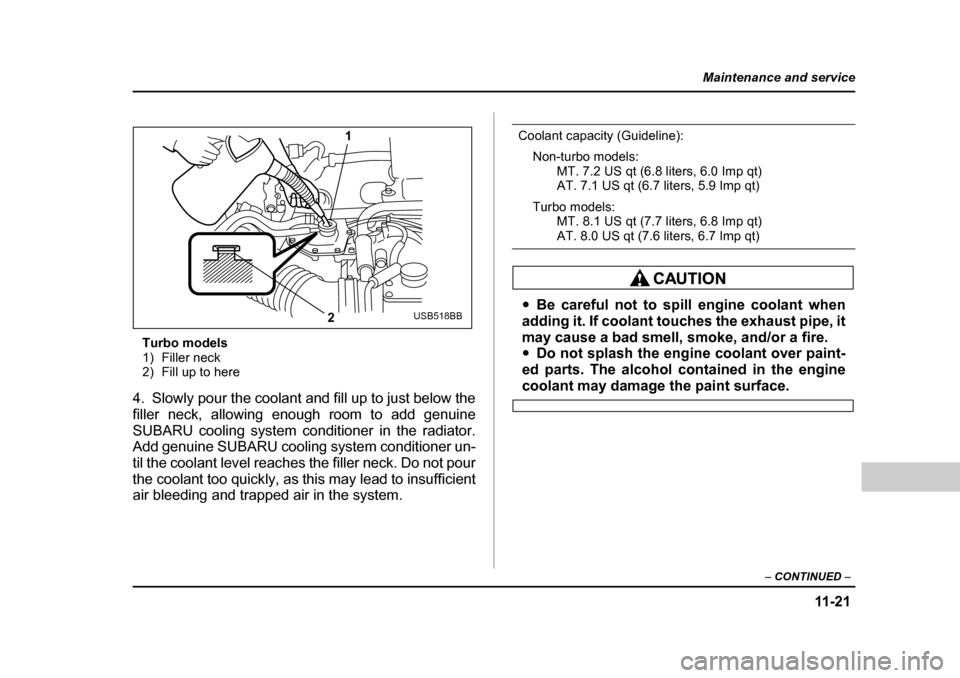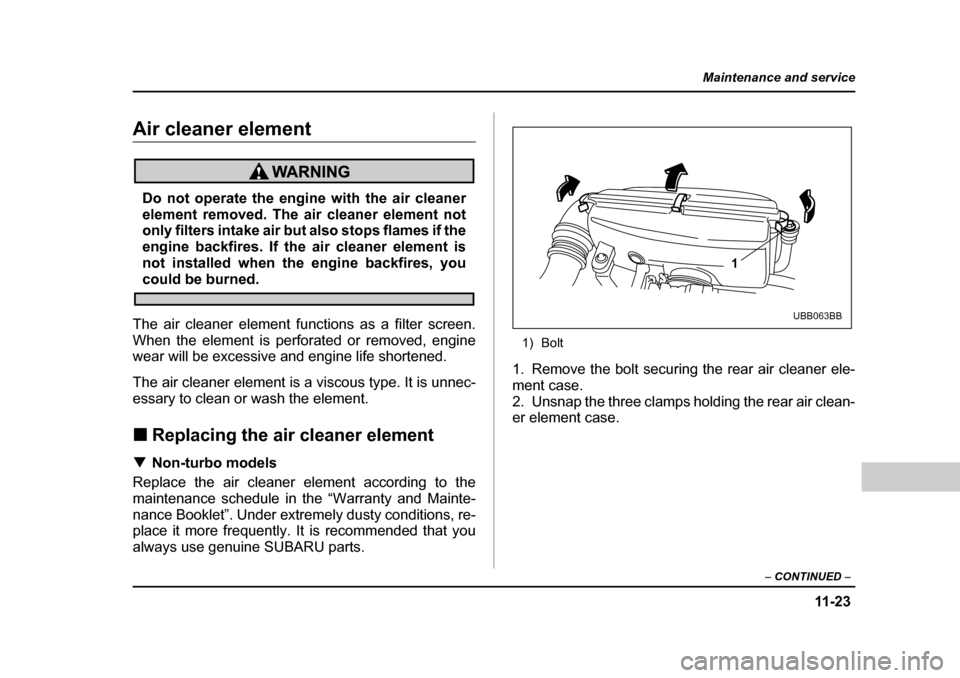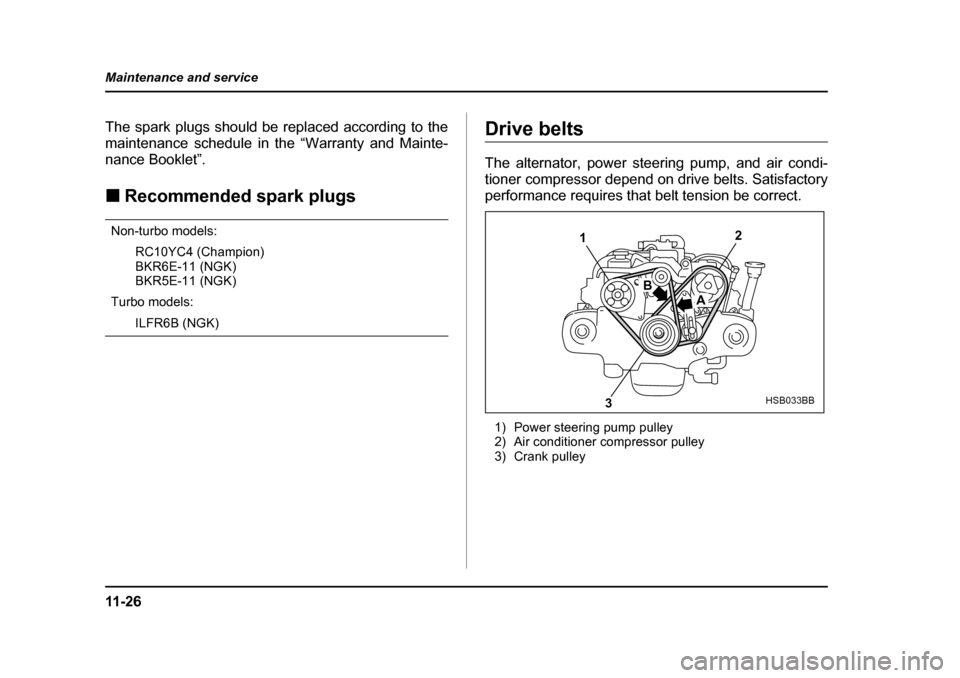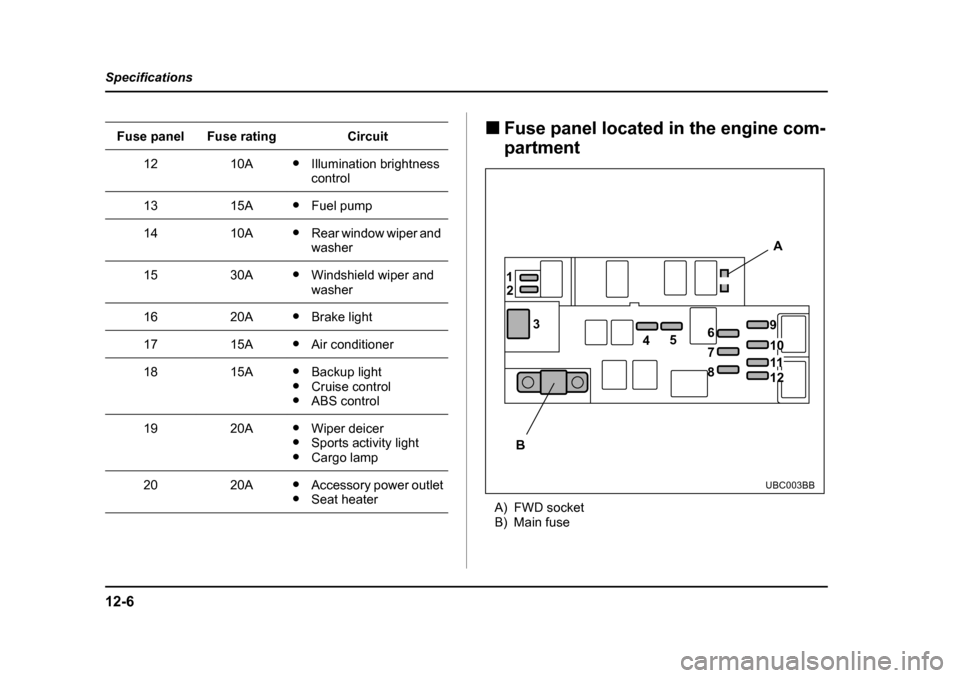2005 SUBARU BAJA air condition
[x] Cancel search: air conditionPage 348 of 469

10-5
Appearance care
– CONTINUED –
Corrosion protection
Your SUBARU has been designed and built to resist
corrosion. Special materials and protective finishes
have been used on most parts of the vehicle to help
maintain fine appearance, strength, and reliable oper-
ation. �„Most common causes of corrosion
The most common causes of corrosion are:
1. The accumulation of moisture retaining dirt and de-
bris in body panel sections, cavities, and other areas.
2. Damage to paint and other protective coatings
caused by gravel and stone chips or minor accidents.
Corrosion is accelerated on the vehicle when:
1. It is exposed to road salt or dust control chemicals,
or used in coastal areas where there is more salt in the
air, or in areas where there is considerable industrial
pollution.
2. It is driven in areas of high humidity, especially
when temperatures range just above freezing.
3. Dampness in certain parts of the vehicle remains
for a long time, even though other parts of the vehicle
may be dry.
4. High temperatures will cause corrosion to parts of
the vehicle which cannot dry quickly due to lack of proper ventilation. �„
To help prevent corrosion
Wash the vehicle regularly to prevent corrosion of the
body and suspension components. Also, wash the ve-
hicle promptly after driving on any of the following sur- faces: �y roads that have been salted to prevent them from
freezing in winter �y mud, sand, or gravel
�y coastal roads
After the winter has ended, it is recommended that the
underbody be given a very thorough washing.
Before the beginning of winter, check the condition of
underbody components, such as the exhaust system,
fuel and brake lines, brake cables, suspension, steer-
ing system, floor pan, and fenders. If any of them are
found to be rusted, they should be given an appropri-
ate rust prevention treatment or should be replaced.
Contact your SUBARU dealer to perform this kind of
maintenance and treatment if you need assistance.
Repair chips and scratches in the paint as soon as you
find them.
Check the interior of the vehicle for water and dirt ac-
Page 352 of 469

11 - 1
11
Maintenance and service
Maintenance schedule ................................. 11-3
Maintenance precautions ............................ 11-3 Before checking or servicing in the engine compartment .................................................. 11-4
When you do checking or servicing in the engine compartment while the engine is
running ............................................................ 11-5
Engine hood .................................................. 11-5
Engine compartment overview ................... 11-8 Non-turbo models ............................................. 11-8
Turbo models .................................................... 11-9
Engine oil ...................................................... 11-10 Checking the oil level ....................................... 11-10
Changing the oil and oil filter .......................... 11-12
Recommended grade and viscosity ................ 11-15
Recommended grade and viscosity under severe driving conditions .............................. 11-16
Cooling system ............................................. 11-17 Hose and connections ...................................... 11-18
Engine coolant .................................................. 11-18
Air cleaner element ...................................... 11-23 Replacing the air cleaner element ................... 11-23
Spark plugs ................................................... 11-25 Recommended spark plugs ............................. 11-26
Drive belts ..................................................... 11-26
Manual transmission oil ............................... 11-27 Checking the oil level ....................................... 11-27
Recommended grade and viscosity ................ 11-28
Automatic transmission fluid ...................... 11-29 Checking the fluid level .................................... 11-29
Recommended fluid ......................................... 11-31
Front differential gear oil (AT vehicles) ...... 11-32 Checking the oil level ....................................... 11-32
Recommended grade and viscosity ............... 11-32
Rear differential gear oil ............................... 11-33 Checking the gear oil level .............................. 11-33
Recommended grade and viscosity ............... 11-35
Power steering fluid ...................................... 11-36 Checking the fluid level .................................... 11-36
Recommended fluid ......................................... 11-37
Brake fluid ..................................................... 11-38 Checking the fluid level .................................... 11-38
Recommended brake fluid ............................... 11-39
Clutch fluid (MT vehicles) ............................ 11-39 Checking the fluid level .................................... 11-39
Recommended clutch fluid .............................. 11-40
Brake booster ................................................ 11-41
Brake pedal .................................................... 11-41 Checking the brake pedal free play ................ 11-41
Checking the brake pedal reserve distance ... 11-42
Clutch pedal (Manual transmission vehicles) ............... 11-42Checking the clutch function .......................... 11-42
Checking the clutch pedal free play ............... 11-43
Replacement of brake pad and lining ......... 11-43 Breaking-in of new brake pads and linings .... 11-44
Parking brake stroke .................................... 11-45
Tires and wheels ........................................... 11-45
Page 372 of 469

11 -2 1
Maintenance and service
– CONTINUED –
Turbo models
1) Filler neck
2) Fill up to here
4. Slowly pour the coolant and fill up to just below the
filler neck, allowing enough room to add genuine
SUBARU cooling system conditioner in the radiator.
Add genuine SUBARU cooling system conditioner un-
til the coolant level reaches the filler neck. Do not pour
the coolant too quickly, as this may lead to insufficient
air bleeding and trapped air in the system.
Coolant capacity (Guideline): Non-turbo models: MT. 7.2 US qt (6.8 liters, 6.0 Imp qt)
AT. 7.1 US qt (6.7 liters, 5.9 Imp qt)
Turbo models: MT. 8.1 US qt (7.7 liters, 6.8 Imp qt)
AT. 8.0 US qt (7.6 liters, 6.7 Imp qt)
�yBe careful not to spill engine coolant when
adding it. If coolant touches the exhaust pipe, it
may cause a bad smell, smoke, and/or a fire. �y Do not splash the engine coolant over paint-
ed parts. The alcohol contained in the engine
coolant may damage the paint surface.
1
2
USB518BB
Page 374 of 469

11 -2 3
Maintenance and service
– CONTINUED –
Air cleaner element
Do not operate the engine with the air cleaner
element removed. The air cleaner element not
only filters intake air but also stops flames if the
engine backfires. If the air cleaner element is
not installed when the engine backfires, you
could be burned.
The air cleaner element functions as a filter screen.
When the element is perforated or removed, engine
wear will be excessive and engine life shortened.
The air cleaner element is a viscous type. It is unnec-
essary to clean or wash the element. �„ Replacing the air cleaner element
�T Non-turbo models
Replace the air cleaner element according to the
maintenance schedule in the “Warranty and Mainte-
nance Booklet”. Under extremely dusty conditions, re-
place it more frequently. It is recommended that you
always use genuine SUBARU parts.
0
1) Bolt
1. Remove the bolt securing the rear air cleaner ele- ment case.
2. Unsnap the three clamps holding the rear air clean-
er element case.
1
UBB063BB
Page 377 of 469

11 - 2 6
Maintenance and service
The spark plugs should be replaced according to the
maintenance schedule in the “Warranty and Mainte-
nance Booklet”. �„
Recommended spark plugs
Non-turbo models:
RC10YC4 (Champion)
BKR6E-11 (NGK)
BKR5E-11 (NGK)
Turbo models:
ILFR6B (NGK)
Drive belts
The alternator, power steering pump, and air condi-
tioner compressor depend on drive belts. Satisfactory
performance requires that belt tension be correct.
1) Power steering pump pulley
2) Air conditioner compressor pulley
3) Crank pulley
2
3 A
B
1
HSB033BB
Page 437 of 469

12-6
Specifications
�„
Fuse panel located in the engine com- partment
A) FWD socket
B) Main fuse
1210A�y Illumination brightness control
1315A�yFuel pump
1410A�yRear window wiper and washer
1530A�yWindshield wiper and washer
1620A�yBrake light
1715A�yAir conditioner
1815A�yBackup light
�y Cruise control
�y ABS control
1920A�yWiper deicer
�y Sports activity light
�y Cargo lamp
2020A�yAccessory power outlet
�y Seat heater
Fuse panelFuse ratingCircuit
A
B
1
2
3 45 6 7 8 9 10 11 12
UBC003BB
Page 448 of 469

13-7
Consumer information and Reporting safety defects
– CONTINUED –
The maximum cold inflation pressure to which a
tire may be inflated. �yRecommended inflation pressure
The cold inflation pressure recommended by a
vehicle manufacturer. �y Intended outboard sidewall
1)The sidewall that contains a whitewall, bears
white lettering or bears manufacturer, brand,
and/or model name molding that is higher or
deeper than the same molding on the other
sidewall of the tire, or
2)The outward facing sidewall of an asymmet-
rical tire that has a particular side that must al-
ways face outward when mounting on a vehi-
cle.
�y Accessory weight
The combined weight (in excess of those stan-
dard items which may be replaced) of floor mats,
leather seats, cross bars and cargo bed extender
to the extent that these items are available as
factory-installed equipment (whether installed or
not). �y Curb weight
The weight of a motor vehicle with standard
equipment including the maximum capacity of fu- el, oil, and coolant and air conditioning.�y
Maximum loaded vehicle weight
The sum of curb weight, accessory weight, vehi-
cle capacity weight and production options weight. �y Normal occupant weight
150 lbs (68 kg) times the number of occupants (2
occupants). �y Occupant distribution
Distribution of occupants in a vehicle, 2 in front. �y Production options weight
The combined weight of those installed regular
production options weighing over 5.1 lbs (2.3 kg)
in excess of those standards items which they
replace, not previously considered in curb weight
or accessory weight. �y Vehicle capacity weight
The total weight of cargo, luggage and occu-
pants that can be added to the vehicle. �y Vehicle maximum load on a tire
Load on an individual tire that is determined by
distributing to each axle its share of the maxi-
mum loaded vehicle weight and dividing by two. �y Vehicle normal load on a tire
Load on an individual tire that is determined by
Page 459 of 469

14-2
Index
A
ABS (Anti-lock Brake System) ........................... 7-33
Warning light ................................................. 3-12
Accessories .............................................. 5-4, 11-60
Air cleaner element ......................................... 11-23
Air conditioner operation ................................... 4-10
Air filtration system ............................................ 4-13
All-Wheel Drive warning light ............................ 3-14
Aluminum wheels ............................................ 11-52
Antenna system .................................................. 5-2
Anti-lock Brake System (ABS) ........................... 7-33
Ashtray .............................................................. 6-12
AT OIL TEMPerature warning light ................... 3-12
Audio set ............................................................. 5-4
Auto-dimming mirror/compass .......................... 3-29
Automatic transmission ............................ 7-15, 7-21 Capacities ..................................................... 12-3
Fluid ............................................................ 11-29
Selector lever ....................................... 7-16, 7-22
Shift lock release ................................. 7-20, 7-30
SPORTSHIFT mode – Turbo models ........... 7-21
Temperature warning light ............................ 3-12
Automatic/Emergency Locking Retractor
(A/ELR) .......................................................... 1-16
AWD warning light ............................................. 3-14 B
Battery ............................................................. 11-56
Jump starting ................................................ 9-18
Replacement (Remote keyless entry system) ...................................................... 2-10
Bed extender ..................................................... 6-17Brake Booster ....................................................... 11-41
Fluid ............................................................ 11-38
Pad and lining ............................................. 11-43
Pedal .......................................................... 11-41
Brake pedal
Free play .................................................... 11-41
Reserve distance ........................................ 11-42
Brake system .................................................... 7-32
Warning light ................................................ 3-13
Braking .............................................................. 7-32
Breaking-in of new brake pads and linings ....................................................... 11-44
Tips ............................................................... 7-32
Bulb Chart ............................................................. 12-8
Replacing ................................................... 11-61
C
Capacities ......................................................... 12-3